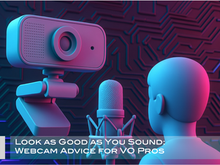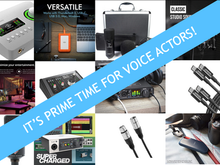A Home Studio Primer
- Frank Verderosa
- Dec 1, 2023
- 5 min read
Everything you need to know to stay competitive as a voice actor working from home!
Whether you're a newcomer or a working voice actor, you need to have a firm understanding of the basics for a solid home studio. Covid lockdown was a watershed moment for voice acting, and it has forever changed the business in many ways. On December 5th, I'll be running the latest version of my Home Studio Primer- a class I started teaching just before lockdown and have used to help thousands of actors become broadcast ready from home.
Even today when I cast projects for my ad agency clients, I'm amazed by how many great actors don't yet have a home studio nailed down. Many people are under the false impression that simply buying a great mic is all you need to do. Others have been led to believe that a cheap USB mic will suffice. As we exit the Covid era and settle into a new normal, what you need largely depends on the work you're chasing. However, no matter what work you'll be doing, there are certain issues that simply must be worked out.
Prior to covid, self taping voice auditions was already becoming the norm. I was still doing primarily live, directed casting- but would allow self tapes for people that couldn't get in or didn't want to. 99 percent of the time, the people that booked my jobs were the people that showed up. There were a few factors at play in those situations. When you were in person, you got instant feedback if you were missing the joke or misinterpreting the copy. At home, you're just reading, submitting, and hoping for the best. But quality was also a big factor. Most people, at the instruction of their agents, got a cheap USB mic and would record under a blanket or just in the middle of their living room. The resulting poor sound quality definitely didn't help clients hear what you're capable of- especially when you're being submitted alongside actors that came to a professional studio to read. On top of that, actors would often butcher their reads while editing, making what might have been an innocent attempt at cleaning up a file seem like it took a dozen reads to cut together a single 30 second commercial!
Many people are under the false impression that simply buying a great mic is all you need!
Along came Covid, and in-person auditioning was off the table. I quickly pivoted to face-to-face casting via Zoom with Source Connect to emulate what we were all used to, and continue to do that. But we had a dilemma! All of the great actors we were used to seeing in NYC that work on stage or on-camera for TV commercials, shows, movies, etc, didn't have elaborate home studios because they never needed them. On the other hand, there was an existing army of well equipped voice actors that had good setups, but often lacked the acting skills needed to deliver what clients expected. In an effort to level the playing field, I began offering the Home Studio Primer. But every so many months, that class would have to change and adapt to what is currently happening in the industry- particularly, in my case, for commercial sessions.
So what is required? Well, for starters, I wish that talent agents and casting directors would changed their verbage on breakdowns from "must have a home studio" to "must have a home studio unless you live where the job is being done". Any studio engineer will tell you that mediocre home setups are the bane of our existence. Issues range from poor mic placement, too small a booth (yielding a boxy sound due to comb filtering), too high a noise level, and dealing with anything from barking dogs to sirens going by. Some clients are more patient than others with this- but if you live in NYC or the surrounding area, and the job is being produced there, there is likely a booth at the studio with your name on it! I recently did a job where the talent agent seemed to insist on the voice actor working from home in a setup that was just barely ok, only to find out that the actor would have much rathered come to the studio.
But if you live somewhere outside of where the job is being done or anywhere in between, how do you remain competitive with your setup? Remember, the high end car commercial audition that you just received has people with really expensive setups audutioning alongside people with that cheap USB mic and no real booth. While performance is king, if you don't live where the job is being produced and the client isn't going to pay for another studio- you're probably getting skipped over!
I wish that talent agents and casting directors would changed their verbage on breakdowns from "must have a home studio" to "must have a home studio unless you live where the job is being done".
I will also tell you that I encounter many actors all around the country that feel that they have a professional home studio, but actually have many of the flaws discussed earlier. The biggest hurdle tends to be acoustics, which is why we focus so much on that in my class. But other issues, like not having a handle on Source Connect (which is why I continue to run my class on that and other connectivity issues), not being able to manage Zoom and Source Connect, and so much more. I continue to see people in my evaluation sessions who didn't realize there were issues in their studios despite auditioning all day every day!

So what makes a home studio? My class breaks it down in this order:
Acoustics: not every actors has the budget to soundproof vs. acoustically treat a space. We'll go over what works and what doesn't - and what to avoid.
Microphones: there's something for every budget, but a lot depends on your voice and your space. We'll get into all of it.
Interfaces: there's a wide range to choose from. I'll highlight the differences, pros and cons of the most popular units.
Connectivity: Source Connect, Zoom, etc). We''ll go over the options, how they work and what you need.
DAWs: We'll discuss different recording software, including the updsides and downsides of some of the most popular programs.
Processing: we'll discuss best practices based on what's happening in the business in terms of processing your audio.
As always, we'll have ample time for Q&A to make sure you have a firm grip on it all as you make your plans! I'll also send a follow-up PDF that reviews the entire class so you can focus on the discussion and not worry about notes so much.































Comments